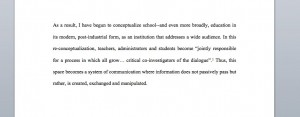re-flec-tion
noun
4. A thought occurring in consideration or meditation
“All we know about our culture, we know through the mass media.”
Niklas Luhmann, The Reality of the Mass Media
As today was my last scheduled visit to School One, I thought it fit to reflect on the material that I have compiled over the semester. In the process of reflecting, I realised that putting together a case study (my initial goal in this endeavor) would be impossible without considering the different analytical frameworks at play within the space of the school. “Technology in Education” is too broad a phrase; multiple aspects are involved in the process of technology integration which come with their own methods of analysis. For example, considering the shifting ways in which students are presenting information (through multimodal texts) requires a bit of literary theory, a dash of filmic analysis, and perhaps a brief consideration of the “nuts and bolts” of the digital medium. Of course, this changes depending on project but my example illuminates the different fields this type of analysis draws upon. Broadly examining and discussing technology use in classrooms requires drawing on multiple fields and disciplines; digital technology demands an interdisciplinary approach to its analysis.
Furthermore, I also considered how digital technology fits into the framework of the classroom. Digital “tools” (as I have mentioned previously) are not necessarily appendages to the pre-existing fabric of the classroom. Rather, they integrate themselves into whichever situation they are used in as a result of their user’s social practices. The students at School One especially demonstrate the emergence of a participatory culture, an inherent understanding of media convergence, and a developing sense of what it means to be a “multimodal scholar”. When this is taken into consideration, digital technology is no longer seen as an imposition to students. Rather, digital technology merely reflects the pre-existing social practices of the time. Thus, the question is not why we should incorporate digital tools into our classrooms. Instead, the question is why shouldn’t we?
Though the ideas of media convergence and participatory cultures indicate an increased sense of collaboration and co-creation, my field notes and observations point to the contrary. Leveraging new media promises to augment communication and discussion but from what I’ve come to understand, collaboration and co-creation prove highly contingent on the preexisting physical infrastructure in which they are located (in this case, in education). As Alison Cook-Sather suggests, education can be understood as a constant process of translation — all learners are both translators and the subject of translation. This particular mechanism is already in place within the school and digital technology does not necessarily change this core foundation. Digital technology simply works with what’s already in place, rather than alter it entirely. Certain patterns will always persist.
Consequently, the idea of technology within a school setting cannot be isolated as an active agent. Interdisciplinary approaches, cognizance of our social practices, and an integration of both physical and generative spaces are required in order to fully understood the processes at play when considering the role of technology in education.


